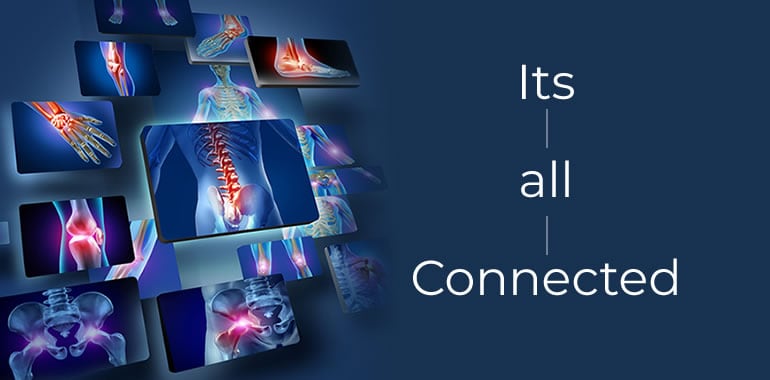
Have you ever been to see a Physical Therapist with complaints of low back pain and they are watching you walk or talking to you about your foot? Have you ever questioned (to yourself or out loud!) why they are discussing your knee movement or hip strength when you came in because you can’t sleep because of back pain? Have you ever wondered what is going through their minds? I am here to tell you –
It’s all connected! There are two bones, the tibia and fibula, that run between the ankle and the knee. As we age, all bones become stronger and less flexible. By the time we are adults, the bones have very little “give” or movement in them. So, any movement that occurs through the ankle is transferred through these bones up to the knee.
Helping to move the foot and knee through daily activity are several muscles. Many of these muscles start just below the knee and cross the ankle joint to insert into the foot. These are the muscles that help your foot move up, down, and side to side. The big muscles in your calf even cross above the knee joint!
On top of all this you have fascia.
Have you ever tried to pull fat off a raw steak? You know that silvery white stuff that firmly holds the fat onto the steak – THAT is fascia!
The fascia is what holds everything together under our skin. There is fascia throughout our body and there are thick sheets of fascia that help to keep the lower leg connected – to each other and to the rest of the body.
Moving on up the leg, we have the largest and strongest bone in our bodies – the femur! The weird thing about the femur is that it has a ball at one end and a straight edge at the other end. Also, it doesn’t run completely up and down. Instead, it runs at an angle which makes the hips wider than the knees. So, any force that is coming up through the ankles and into the knees has to take a turn before it heads into the hips. This has the potential to be a turn for the worse!
Between the hip and the knee we find many big, strapping muscles – the quadriceps (in the front) and the hamstrings (in the back). These big muscles help to get the hip and knee moving which allows the foot to be in the optimum position to walk, jump, run, or play. If these muscles are having any problems then the foot has difficulty connecting to the ground. The reverse is also true – if the foot has any restriction that limits motion then the knee/hip will not receive the required motion they need. The problem that starts in one area can easily lead up (or down) the chain!
Remember that fascia? Well, along the outside of our leg we have the largest single piece of fascia in our bodies – the iliotibial band (or ITB for short). The ITB is a thick, fibrous band that starts from the gluteus medius on the side of the hip and inserts into the fibular head. The ITB directly transfers force from the lateral hip into the knee joint – and vice versa! This band can particularly be a problem for women as our hips are wider than our knees. Pro tip – pain in the ITB may be due to weakness in the gluteus medius!
Moving up the chain and headed towards the low back, we cross the pelvis. The pelvis is made of 3 bones. One ilium on each side and a sacrum in the middle. The spinal column stacks up onto the sacrum. So, the 5 lumbar vertebrae stack up onto the sacrum which is attached to an ilium on either side.
What holds all that together? There are muscles that help to connect the lumbar spine to the sacrum, the ilium, and the femur. There are muscles to connect the ilium and the sacrum (this is often called your pelvic floor). And, of course, the silvery/white fascia helps to hold all these bones, muscles, tendons, and ligaments together.
Now, I don’t mean to get controversial here but I am just going to say it – the ilium move on the sacrum! If that makes sense to you – HOORAY! This is a huge discussion among health care practitioners that has received endless debate. You see, the ilium and sacrum are connected by very thick, fibrous ligaments that allow for very little movement in the pelvis. This helps to provide stability for the pelvis while you are performing daily activities. However, too much movement can be a big problem.
Back to our foot-low back connection. If your foot doesn’t interact with the ground the way it should, this can cause an immediate pain (as in our example of stepping off the curb above) or cause a wearing of the joints over time in your low back. If you challenge your muscles to work harder by walking in the sand, this can actually improve the muscle control through the foot that decreases the stress on the joints in your low back.
As you can see, the bio-mechanics through our legs are complicated. Each bone, muscle, and joint interacts with other bones, muscles, and joints to allow us to move through our environments. This is why your body deserves a full, comprehensive evaluation of the pain or dysfunction you are experiencing. And why Physical Therapists look at your foot, knee, hip, and pelvis while talking about your low back pain.



